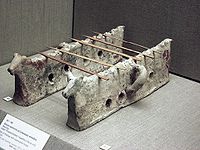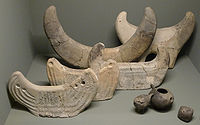- Fire dog
-
A fire dog (also firedog) is a device of metal or ceramic intended to hold logs above the hearth (and so improving air circulation for faster burning), or to hold skewers above the fire for cooking.
"Fire dog", also moon idol or moon horn (German Mondhorn), also refers to an artifact type of late Bronze Age Europe (ca. 1300 to 800 BC), typically made of clay, found in the area of modern France, Switzerland and Germany, associated with the Urnfield culture. This naming suggests that moon idols could have been used as andirons to build up fire dogs.
In some cases moon idols are apparently a cult item of Early European Religion, resembling a pair of horns or crescent moons on a pedestal, and was variously interpreted as testifying to Bull worship, Moon worship, or as a holder for wooden logs to be used in a fire altar.
Literature
- Babes, M. und Mihailescu-Bîrliba, V.: Germanische latènezeitliche "Feuerböcke" aus der Moldau 1971
- Mondhörner - "Urgeschichtliche Messgeräte" in Helvetica Archäologica 32/2001
- Derungs K.: Geheimnisvolles Zürich ISBN 3-905581-22-1
- Steuer, H.: "Germanische 'Feuerböcke' aus dem Hannoverschen Wendland", Arch. Korrespondenzbl. 3, 1973

This article relating to archaeology in Europe is a stub. You can help Wikipedia by expanding it.


